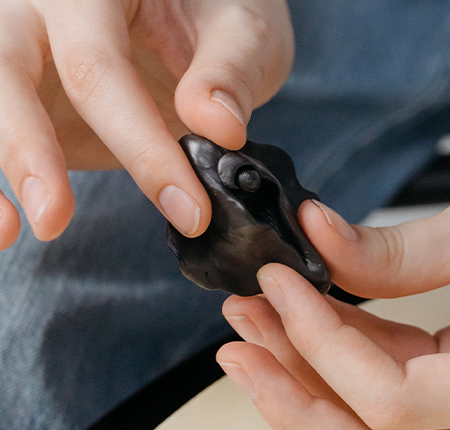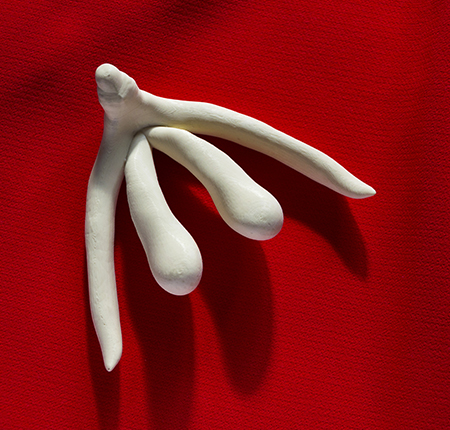
A mystery for quite a few of us and (still) a controversial topic—as is sex education in Romania. How about putting the spotlight on one of the most recently discovered parts of the female body? Throughout history, the clitoris has been stigmatized, but it's never too late to give it a voice. So what is it, what is its role and why should you know more about the clitoris? Find out in this article.
What is the clitoris?
The main source of most female orgasms—the clitoris—is part of the vulva and is located on top of it. It is the most pleasure-receptive area in our body, but only a small part is visible, most of its body being inside.

For a long time, the clitoris was considered the main female sexual organ, until the 19th century, when this perspective changed and the vagina came into focus (hence the association of female sexuality with childbearing). At the beginning of the 20th century, however, Freud brought the clitoris back into focus and with it, the female orgasm. It is the first time that two types of orgasm are mentioned: clitoral and vaginal - but you will read about them further down in the article.
Where is the clitoris and what is it made of?
What we see of the clitoris is found at the top of the vulva, where the labia meet. Under the clitoral hood, hides the glans—or head of the clitoris. It contains up to 8,000 nerve endings, more than any other part of the human body (female or male). And if you want a comparison, the penis has only 4000 nerve endings, while the tips of the fingers have about 2500.

From the point of view of embryonic development, the clitoris has the same origin as the penis, starting from the same anatomical structure.
At maturity, its inner body divides into two legs that surround the urethra and vagina, and next to each "leg" are the clitoral bulbs that surround the vaginal walls on either side.
Think of the clitoris as a starting point: nerve fibers up to 15 cm long start from here, which can reach the inner thighs or various parts of the lower abdomen.
How (and why) the clitoris changes
Maybe you didn't know this:
The clitoris is the only part of the human body that never ages.
Studies say that an 80-year-old's clitoris works just as well as a 20-year-old's!
In contrast, the size of the clitoris changes throughout life. It grows along with the other genitals during puberty, and the size varies greatly from person to person. Hormones partly determine its size, although size doesn't matter because it has no impact on clitoral sensitivity or performance. The length varies, and some people are born with a longer glans. The body usually measures 2-5 cm in length, the croup around 9 cm, and the clitoral bulbs 3-7 cm.
What is clitoral stimulation?
For most women, clitoral stimulation is the surest way to orgasm. It is also the most common form of female masturbation, menstruating or not , with or without a partner.
As pleasure is subjective , there are countless clitoral stimulation methods and techniques. Some people prefer light, gentle stimulation, certain sex positions that favor it, and others prefer harder, more precise or rhythmic stimulation. There is no stimulation manual, but there is sexual fantasy and imagination: how much, frequently, rhythmically, lightly, hard or intensely you stimulate the clitoris until you reach orgasm depends on your preferences. It's good to know that there are several stages of arousal and the glans can be so sensitive that direct touch can be painful—especially if you don't use lube.
As for cunnilingus, there are also many variations of oral sex: you may like kissing, pinching, licking the entire vulva area or between the labia, firm massage with the tip of the tongue around the clitoris or even on it.
Clitoral and vaginal orgasm
During arousal, the erectile tissue—the entire clitoris—receives blood and stimulates nerve endings. All parts of the clitoris swell and become stiffer, and it becomes erect. The inner labia may be three times larger than normal and the outer labia also swell. The vagina naturally stretches, deepens and lubricates itself, while the glands at the vaginal opening also secrete a fluid.
All these processes prepare you for orgasm. But what is the difference between vaginal and clitoral?
Although it is very possible to have an orgasm just after penetration, vaginal orgasm (especially without foreplay or preparation) is rather an exception. Studies show that around 80% of women need more than penetration to orgasm—which involves clitoral stimulation. But unfortunately, pleasure taboos have hindered research in the field, and we still don't know much.
We know, however, that there are already studies about the famous G-spot, and some researchers suggest that the G-spot is not necessarily a physical entity, but the place where the sides of the clitoral bulbs come into contact with the anterior wall of the vagina. Which means that a "vaginal orgasm" may actually be a clitoral orgasm.
Irritations and dryness
But not everything is perfect when we talk about the "pleasure center".
Dryness and irritation around the labia and clitoris (not just vaginal dryness ) can be common problems. What are the causes?
Dryness is most often caused by washing the vulva too frequently and using harsh soaps. In addition, using conventional menstrual products that contain plastic and toxic ingredients is a problem: it can cause irritation and allergies.
A tip: avoid too harsh soaps and choose organic cotton underwear and menstrual products .
In short…
The clitoris:
It is the only organ in the body that has only the role of producing pleasure
It never gets old
It has around 8000 nerve endings, twice as many as the penis
It was rendered in 3D for the first time in 2009
It can reach up to 12 cm in length
When stimulated, it changes size and color
Read more in the Intimate Journal !






















